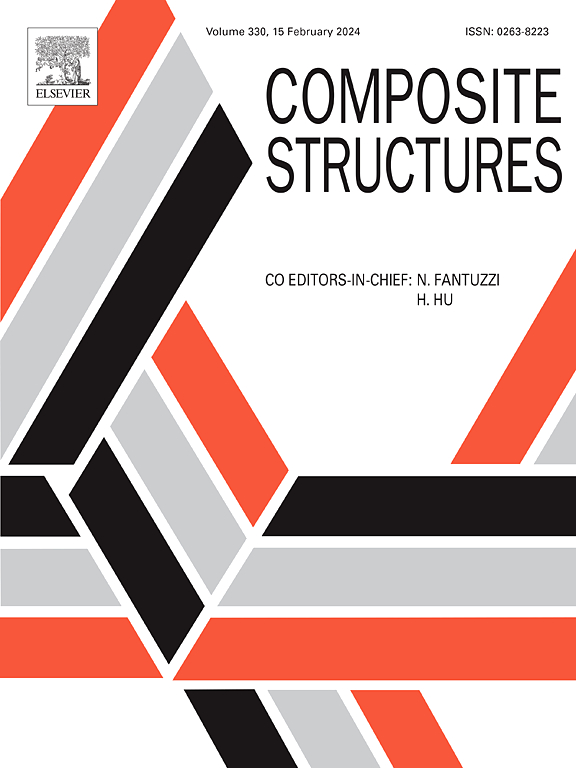高性能复合大纤维对无箍筋加筋梁抗剪性能的影响
IF 6.3
2区 材料科学
Q1 MATERIALS SCIENCE, COMPOSITES
引用次数: 0
摘要
尽管大量的研究调查了钢纤维作为混凝土结构抗剪钢筋的有效性。本研究研究了一种新型高性能复合大纤维(HPCF)用于钢筋梁的剪切加固,鼓励其在建筑中的应用。制作了三组纵向加筋梁,这些梁缺乏抗剪钢筋,但含有不同的HPCF含量。采用四点弯曲试验、非线性有限元建模和基于现行设计规范的理论分析等多方法验证方法。利用数字图像相关技术(DIC)监测了全场应变和裂纹演化,从而能够详细评估裂纹的起裂和宽度的发展。结果表明,较低比例的HPCF显著提高了梁的抗剪能力。通过验证的有限元模型,进一步探讨了纵向配筋率(ρL)和剪切配筋率(ρV)对HPCF梁抗剪性能的影响。最后,利用不同设计规范中概述的理论模型,对仅使用HPCF作为抗剪钢筋的安全边际进行了评估。虽然FprEC2:2022仅适用于钢纤维,但它也适用于HPCF。总的来说,实验、数值和理论结果都支持在混凝土梁中使用HPCF作为传统剪力钢筋的可靠替代方案的可行性。本文章由计算机程序翻译,如有差异,请以英文原文为准。
Effect of high performance composite macrofiber on the shear behavior of reinforced beams without stirrups
Although numerous studies have investigated the effectiveness of steel fibers as shear reinforcement in concrete structures. The present study investigates a novel high-performance composite macrofiber (HPCF) for shear reinforcement in reinforced beams, encouraging its use in construction. Three groups of longitudinally reinforced beams, lacking shear reinforcement but containing varying HPCF contents, were fabricated. A multi-method validation approach was adopted, including four-point bending test, nonlinear finite element (FE) modeling, and theoretical analysis based on current design codes. Full-field strain and crack evolution were monitored using Digital Image Correlation (DIC), enabling a detailed evaluation of crack initiation and width development. Results revealed that a relatively low fraction of HPCF significantly enhanced beam’s shear capacity. The validated FE models were further used to explore the influence of longitudinal (ρL) and shear (ρV) reinforcement ratios on the shear behavior of beams with HPCF. Finally, safety margins of using HPCF as only shear reinforcement were evaluated using theoretical models outlined in different design codes. Although formulated only for steel fibers, FprEC2:2022 is shown to perform well also for HPCF. Overall, the experimental, numerical and theoretical findings support the feasibility of using HPCF as a reliable alternative to traditional shear reinforcement in concrete beams.
求助全文
通过发布文献求助,成功后即可免费获取论文全文。
去求助
来源期刊

Composite Structures
工程技术-材料科学:复合
CiteScore
12.00
自引率
12.70%
发文量
1246
审稿时长
78 days
期刊介绍:
The past few decades have seen outstanding advances in the use of composite materials in structural applications. There can be little doubt that, within engineering circles, composites have revolutionised traditional design concepts and made possible an unparalleled range of new and exciting possibilities as viable materials for construction. Composite Structures, an International Journal, disseminates knowledge between users, manufacturers, designers and researchers involved in structures or structural components manufactured using composite materials.
The journal publishes papers which contribute to knowledge in the use of composite materials in engineering structures. Papers deal with design, research and development studies, experimental investigations, theoretical analysis and fabrication techniques relevant to the application of composites in load-bearing components for assemblies, ranging from individual components such as plates and shells to complete composite structures.
 求助内容:
求助内容: 应助结果提醒方式:
应助结果提醒方式:


